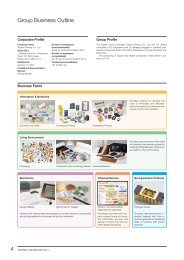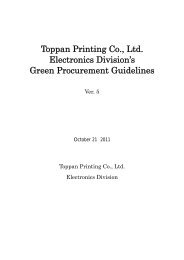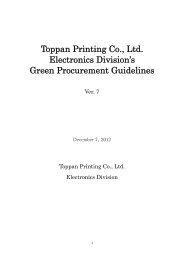A N N U A L R E P O R T 1 9 9 9
A N N U A L R E P O R T 1 9 9 9
A N N U A L R E P O R T 1 9 9 9
You also want an ePaper? Increase the reach of your titles
YUMPU automatically turns print PDFs into web optimized ePapers that Google loves.
The aggregate annual maturities of long-term loans subsequent<br />
to March 31, 1999, are as follows:<br />
Fiscal year ending March 31 Millions of yen Thousands of dollars<br />
2001 ¥711 $5,876<br />
2002 534 4,413<br />
2003 646 5,339<br />
2004 487 4,025<br />
2005 and thereafter 981 8,107<br />
4. Income Taxes<br />
The Company and its subsidiaries are subject to several taxes<br />
(corporate, inhabitant and enterprise) based on income. The<br />
aggregate statutory tax rates and the effective tax rates for the<br />
years ended March 31, 1997, 1998 and 1999 are as follows:<br />
1997 1998 1999<br />
Statutory tax rate 51% 51% 47%<br />
Effective tax rate 71% 56% 49%<br />
Variance between the statutory tax rates and effective tax rates<br />
for the year ended March 31, 1997, consists primarily of the effect of<br />
permanently non-deductible expenses and non-taxable income. The<br />
effective tax rate for the year ended March 31, 1997, was affected by<br />
the lump-sum write-off of goodwill pertaining to the acquisition of<br />
Toppan Moore Co., Ltd. and Avery Toppan Co., Ltd. in 1997. For<br />
the years ended March 31, 1998 and 1999, the variance consists primarily<br />
of all temporary differences reflected to deferred taxes as a<br />
result of adopting the allocation of income taxes.<br />
Significant components of the Company’s deferred tax<br />
assets and liabilities as of March 31, 1999, are as follows:<br />
Millions of yen Thousands of dollars<br />
(Deferred tax assets)<br />
Bad debt reserve ¥1,277 $ 10,554<br />
Accrued bonuses 950 7,851<br />
Enterprise taxes 1,369 11,314<br />
Depreciation 2,071 17,116<br />
Estimated termination<br />
and retirement allowances 3,799 31,397<br />
Intercompany profits 2,145 17,727<br />
Net operating loss carry forwards 1,691 13,975<br />
Other 3,100 25,620<br />
16,402 135,554<br />
Less valuation allowance (1,691) (13,975)<br />
Total 14,711 121,579<br />
(Deferred tax liabilities)<br />
Tax purpose reserves<br />
regulated by Japanese tax law 3,467 28,653<br />
Other 519 4,290<br />
Total 3,986 32,943<br />
Deferred tax assets, net ¥10,725 $ 88,636<br />
(Fixed liabilities)<br />
Deferred tax liabilities<br />
Depreciation ¥177 $1,463<br />
Other 54 446<br />
Total deferred tax liabilities ¥231 $1,909<br />
The valuation allowance mainly relates to deferred tax assets<br />
of the consolidated subsidiaries with operating loss carryforwards<br />
for tax purposes that are not expected to be realized.<br />
The disclosure of significant components of the Company’s<br />
deferred tax assets and liabilities have been required to be disclosed<br />
under accounting principles from fiscal 1999, but such<br />
accounting principles have not been required to restate the<br />
1998 deferred tax information.<br />
33<br />
5. Shareholders’ Investment<br />
The Japanese Commerical Code provides that an amount equivalent<br />
to at least 10% of cash dividends paid and of other cash outlays<br />
in each fiscal or interim six-month period be appropriated to a legal<br />
reserve until such reserve equals 25% of the issued share capital.<br />
In accordance with the new disclosure requirements effective<br />
from the year ended March 31, 1999, legal reserve of<br />
¥14,709 million ($121,562 thousand) is included in retained<br />
earnings for 1999. Previously it was presented as a separate<br />
component of the shareholders’ investment. The accompanying<br />
consolidated financial statements for the years ended<br />
March 31, 1997 and 1998 have been reclassified to conform<br />
to the 1999 presentation.<br />
The Code also provides that neither the additional paid-in capital<br />
nor the legal reserve is available for cash dividends, but may be<br />
used to reduce a capital deficit by resolution of the shareholders or<br />
may be capitalized by resolution of the Board of Directors.<br />
Year-end dividends are approved by the shareholders after the<br />
end of each fiscal year, and interim dividends are declared by the<br />
Board of Directors after the end of each semi-annual period. In<br />
accordance with the Commercial Code, the year-end dividends and<br />
the related appropriation of retained earnings are not reflected in<br />
the consolidated financial statements at the end of each fiscal year.<br />
On June 30, 1999, the shareholders approved the declaration<br />
of a year-end cash dividend totaling ¥5,246 million ($43,356 thousand),<br />
which was paid in that month to the shareholders of record<br />
as at March 31, 1999, and the related appropriation of profits to<br />
legal reserve of ¥539 million ($4,455 thousand).<br />
6. Per Share Data<br />
Net income per share is based on the weighted average number<br />
of shares of common stock outstanding and dilutive common<br />
stock equivalents. The 1.9% and 1.4% convertible bonds were<br />
considered as common stock equivalents and were included in<br />
the calculation of earnings per share when they were dilutive. In<br />
computing net income per share, net income is adjusted, at net<br />
of income taxes, by interest expense on the convertible bonds.<br />
Dividends per share shown in the accompanying consolidated<br />
statements of income have been presented on an<br />
accrual basis but include dividends approved after each fiscal<br />
year-end and are applicable to the year then ended.<br />
The number of shares of common stock outstanding used<br />
in computing net income per share was as follows:<br />
Thousands of shares<br />
1997 736,805<br />
1998 730,231<br />
1999 730,195<br />
7. Derivative Financial Instruments<br />
The Company uses derivative financial instruments selectively,<br />
to manage interest rate risk and foreign exchange risk.<br />
The Company enters into forward exchange contracts to<br />
hedge foreign exchange risks and also uses interest rate swaps<br />
to manage floating interest rate risk.<br />
To reduce the credit risk of counterparties in derivative<br />
transactions, the Company selects major, creditworthy financial<br />
institutions as counterparties.<br />
The Company has entered into the following types of<br />
derivative financial instruments as of March 31, 1999.






